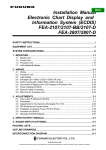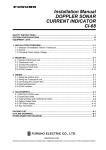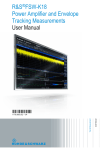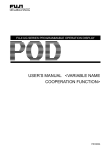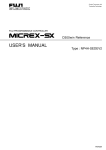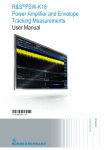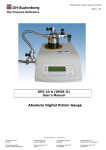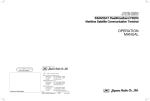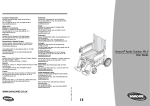Download 3-2 T-link System Configuration
Transcript
series USER'S MANUAL T-LINK MASTER MODULE T-LINK INTERFACE MODULE FEH204 Preface This User’s Manual explains T-link master module, T-link interface module and T-link specifications of MICREX-SX series. Read this manual carefully to ensure correct operation. When using modules or peripheral devices, be sure to read the corresponding user’s manuals listed below. Title Manual No. Contents User's Manual Instruction, MICREX-SX series SPH/SPS FEH200 Explains the memory, language and system definitions of the MICREX-SX series. User's Manual Hardware, MICREX-SX series SPH FEH201 Explains the system configuration, the specifications and operations of modules in the MICREX-SX series. User's Manual P/PE-link modules, MICREXSX series SPH FEH203 Explains the communication specifications of P/PE-link, the specifications and operations of the modules. User's Manual D300win <Introduction>, MICREX-SX series FEH250 Explains the basic operations of D300win, the programming and monitoring for MICREX-SX series. User's Manual D300win <Reference>, MICREX-SX series FEH251 Explains the menu and icon of D300win and all of the operations of D300win. Notes 1. This manual may not be reproduced in whole or part in any form without prior written approval by the manufacturer. 2. The contents of this manual (including specifications) are subject to change without prior notice. 3. If you find any ambiguous or incorrect descriptions in this manual, please write them down (along with the manual No. shown on the cover) and contact FUJI. Safety Precautions Be sure to read the “Safety Precautions” thoroughly before using the module. Here, the safety precaution items are classified into “Warning” and “Caution.” Warning : Incorrect handling of the device may result in death or serious injury. Caution : Incorrect handling of the device may result in minor injury or physical damage. Even some items indicated by “Caution” may also result in a serious accident. Both safety instruction categories provide important information. Be sure to strictly observe these instructions. Warning ◊ Never touch any part of charged circuits as terminals and exposed metal portion while the power is turned ON. It may result in an electric shock to theoperator. ◊ Turn OFF the power before mounting, dismounting, wiring, maintaining or checking, otherwise, electric shock, erratic operation or troubles might occur. ◊ Place the emergency stop circuit, interlock circuit or the like for safety outside the PC. A failure of PC might break or cause problems to the machine. ◊ Do not connect in reverse polarity, charge (except rechargeable ones), disassemble, heat, throw in fire or short-circuit the batteries, otherwise, they might burst or take fire. ◊ If batteries have any deformation, spilled fluids, or other abnormality, do not use them. The use of such batteries might cause explosion or firing. ◊ Do not open the FG terminal with the LG-FG short circuited. (It must be grounded, otherwise it might cause electric shock.) Safety Precautions Caution ◊ Do not use one found damaged or deformed when unpacked, otherwise, failure or erratic operation might be caused. ◊ Do not shock the product by dropping or tipping it over, otherwise, it might be damaged or troubled. ◊ Follow the directions of the operating instructions when mounting the product. If mounting is improper, the product might drop or develop problems or erratic operations. ◊ Use the rated voltage and current mentioned in the operating instructions and manual. Use beyond the rated values might cause fire, erratic operation or failure. ◊ Operate (keep) in the environment specified in the operating instructions and manual. High temperature, high humidity, condensation, dust, corrosive gases, oil, organic solvents, excessive vibration or shock might cause electric shock, fire, erratic operation or failure. ◊ Select a wire size to suit the applied voltage and carrying current. Tighten the wire terminals to the specified torque. Inappropriate wiring or tightening might cause fire, malfunction, failure, or might cause the product to drop from its mounting. ◊ Contaminants, wiring chips, iron powder or other foreign matter must not enter the device when installing it, otherwise, erratic operation or failure might occur. ◊ Connect the ground terminal to the ground, otherwise, an erratic operation might occur. ◊ Periodically make sure the terminal screws and mounting screws are securely tightened. Operation at a loosened status might cause fire or erratic operation. ◊ Put the furnished connector covers on unused connectors, otherwise, failure or erratic operation might occur. ◊ Install the furnished terminal cover on the terminal block, otherwise, electric shock or fire might occur. ◊ Sufficiently make sure of safety before program change, forced output, starting, stopping or anything else during a run. The wrong operation might break or cause machine problems. ◊ Engage the loader connector in a correct orientation, otherwise, an erratic operation might occur. ◊ Before touching the PC, discharge any static electricity that may have been collected on your body. To discharge it, touch a grounded metallic object. Static electricity might cause erratic operation or failure of the module. ◊ Be sure to install the electrical wiring correctly and securely, observing the operating instructions and manual. Wrong or loose wiring might cause fire, accidents, or failure. ◊ When disengaging the plug from the outlet, do not pull the cord, otherwiase, break of cable might cause fire or failure. ◊ Do not attempt to change system configurations (such as installing or removing I/O modules) while the power is ON, otherwise, failure or erratic operation might occur. ◊ Do not attemp to repair the module by yourself -- contact your Fuji Electric agent. When replacing the batteries, correctly and securely connect the battery connectors, otherwise, fire, accidents or failure might occure. ◊ To clean the module, turn power off and wipe the module with a cloth moistened with warm water. Do not use thinner or other organic solvents, as the module surface might become deformed or discolored. ◊ Do not remodel or disassemble the product, otherwise, a failure might occur. ◊ Follow the regulations of industrial wastes when the device is to be discarded. ◊ The modules covered in these operating instructions have not been designed or manufactured for use in equipment or systems which, in the event of failure, can lead to loss of human life. ◊ If you intend to use the modules covered in these operating instructions for special applications, such as for nuclear energy control, aerospace, medical, or transportation, please consult your Fuji Electric agent. ◊ Be sure to provide protective measures when using the module covered in these operating instructions in equipment which, in the event of failure, may lead to loss of human life or other grave results. Revision *Manual No. is shown on the cover. Printed on *Manual No. Revision contents Sep.1998 FEH204 First edition Contents Preface Safety Precautions Revision Contents page Section 1 General ............................................................................................... 1-1 1-1 T-link System Configuration .................................................................................................................. 1-1 Section 2 Specifications .................................................................................... 2-1 2-1 Specifications .........................................................................................................................................2-1 2-2 T-link Communication Specifications ...................................................................................................2-2 2-2-1 Communication specifications ....................................................................................................................... 2-2 2-2-2 Basics of T-link transmission ......................................................................................................................... 2-2 2-2-3 Transmission types ........................................................................................................................................ 2-3 2-3 Cable ........................................................................................................................................................2-4 2-4 Names and Functions ............................................................................................................................2-5 2-4-1 NP1L-TL1 (T-link master module) .................................................................................................................. 2-5 2-4-2 NP1L-RT1 (T-link interface module) .............................................................................................................. 2-7 2-5 Dimensions .............................................................................................................................................2-9 Section 3 System Configuration ....................................................................... 3-1 3-1 Mounting Restrictions ...........................................................................................................................3-1 3-1-1 Mounting position ........................................................................................................................................... 3-1 3-1-2 Number of mountable modules ...................................................................................................................... 3-1 3-2 T-link System Configuration .................................................................................................................. 3-2 3-2-1 Basic system configuration ............................................................................................................................ 3-2 3-2-2 I/O address assignment ................................................................................................................................. 3-3 3-2-3 Communication system with other series using T-link slaves ....................................................................... 3-4 3-2-4 T-link system using the T-link electric repeater/converter ............................................................................. 3-5 3-2-5 System configuration using the T-link optical converter ................................................................................ 3-7 Section 4 System Definitions System Configuration ...................................... 4-1 4-1 System Configuration Definition ..........................................................................................................4-1 4-2 Fail-soft Setting ......................................................................................................................................4-7 4-3 Output Hold Definition ...........................................................................................................................4-9 Section 5 Wiring.................................................................................................. 5-1 5-1 Precautions .............................................................................................................................................5-1 5-2 T-link Wire Assembling ...........................................................................................................................5-2 Section 6 RAS ..................................................................................................... 6-1 6-1 System Memory ......................................................................................................................................6-1 Section 1 General page 1-1 T-link System Configuration ................................................................................... 1-1 Section 1 General 1-1 T-link System Configuration The T-link master module NP1L-TL1 is mounted on the MICREX-SX series base board (connected to the SX bus). This module controls one T-link system which is the Fuji Electric-specific high-speed serial communication network. Various types of T-link devices can be connected as shown in the figure below. SX bus The SX bus transfers data between the T-link and CPU. T-link master module NP1L-TL1 Power supply MICREX-SX series base board CPU 0 T-link High-speed remote I/O link with 500kbps transfer rate. Power supply T-link I/O capsule FALDIC General-purpose inverter T-link I/O group-type unit Digital servo T-link interface module NP1L-RT1 T-link converter Mini T-link (up to 100m) PK2 Bar code reader • • • Note: T-link devices that use conventional loader commands, such as MICREX-F series loaders, FLEX-PC series loaders, and POD, cannot be connected to NP1L-TL1. Mini T-link I/O (up to 10 devices) 1-1 Section 2 Specifications page 2-1 General Specifications ............................................................................................ 2-1 2-2 T-link Communication Specifications .................................................................... 2-2 2-2-1 Communication specifications ........................................................................................... 2-2 2-2-2 Basics of T-link transmission .............................................................................................. 2-2 (1) Initial transmission .............................................................................................................................. 2-2 (2) Normal transmission ........................................................................................................................... 2-2 (3) Transmission errors ............................................................................................................................ 2-2 2-2-3 Transmission types ............................................................................................................ 2-3 (1) I/O transmission .................................................................................................................................. 2-3 (2) Message transmission ........................................................................................................................ 2-3 2-3 Cable ......................................................................................................................... 2-4 2-4 Names and Functions .............................................................................................. 2-5 2-4-1 NP1L-TL1 (T-link master module) ...................................................................................... 2-5 (1) Names ................................................................................................................................................ 2-5 (2) Functions ............................................................................................................................................ 2-5 2-4-2 NP1L-RT1 (T-link interface module) .................................................................................. 2-7 (1) Names ................................................................................................................................................ 2-7 (2) Functions ............................................................................................................................................ 2-7 2-5 Dimensions ............................................................................................................... 2-9 General specifications Section 2 Specifications 2-1 General Specifications Item Physical environmental conditions Mechanical service conditions Electrical service conditions Specification Operating ambient temperature 0 to 55° C Storage temperature -25 to +70° C Relative humidity 20 to 95%RH no condensation (Transport condition: 5 to 95%RH no condensation) Pollution degree 2 Corrosion immunity Free from corrosive gases. Not stained with organic solvents. Operating altitude 2000m or less above sea level (Transport condition: 70kPa or more) Vibration Half amplitude: 0.15mm, Constant acceleration: 19.6m/s2, Two hours for each of three mutually perpendicular axes, total six hours. Shock Acceleration peak: 147m/s2 Three times for each of three mutually perpendicular axes. Noise immunity 1.5kV, rise time 1ns, pulse width 1µs (noise simulator) Electrostatic discharge Contact discharge: ± 8kV Aerial discharge: ± 15kV Radioelectromagnetic 10V/m (80MHz to 1000MHz) field Construction Panel-mounted type Cooling Air cooling Isolation method Photocoupler Dielectric strength 445V AC 1 minute (between connector pins and frame ground) Insulation resistance 10MΩ or more with 500V DC megger (between connector pins and frame ground) Internal current consumption NP1L-TL1: 24V DC, 140mA or less, NP1L-RT1: 24V DC, 140mA or less Mass NP1L-TL1: Approx. 200g, NP1L-RT1: Approx. 200g Dimensions Described in 2-5 2-1 2-2 T-link Communication Specifications 2-2-1 Communication specifications Item Specification No. of connectable devices T-link system slave stations per master module (one T-link system ): Max. 32 No. of I/O points Digital I/O conversion (per T-link system): Max. 128 words (2,048 points) Transmission line format Bus configuration (multi-drop) Optical loop connection through optical converters on each bus (Loops can be duplicated.) Transmission line Bus transmission line: Twisted pair cable (1 pair) Total length: Max. 1km Optical transmission line: SI/GI quartz fiber cable (length between optical converters: Max. 1km/3km) Transmission method Half-duplex, serial transmission Data exchange method 1 : N (polling/selecting) method Transmission speed 500kbps Effective transmission 7kbytes/sec. (10ms/512 digital points) speed Modulation method PDM (Pulse Duration Modulation) Error check FCS (frame check sequence) Duplication of transmission line Optical converters enable duplication of optical transmission lines. 2-2-2 Basics of T-link transmission Data transmission on the T-link uses the polling/selecting method. In the polling/selecting method, the master module first talks to a slave station with the specified station number, then the slave station responds to it. This section describes the basics of the data transmission. (1) Initial transmission When the power is turned on, the master module performs initial transmission before starting to operate. That is, the master module checks the I/O configuration, and the address of (the station number) slave stations connected to the T-link when the power is turned on. The master module checks from station 0 to station 99 in sequence. After checking them completely, the master module starts to operate. When the results of the check are different from settings in the system configuration definition, the “SER” (setting error) lamp lights indicating a configuration error (fatal fault). (3) Transmission errors When an error occurs during T-link transmission, data transmission fails. The master module will retry transmission. An error may occur due to power interruption of a slave station, disconnection of a T-link cable, noise, or malfunction of T-link transmission elements in the master module or slave station. If communication returns to a normal state after transmission retry, T-link transmission continues and the master module continues its operation. If communication still fails after transmission retry has been repeated three times for the same slave station, the master module regards it as a fatal fault and stops operation. In this case, the master module cannot return to operation until the cause of the fault is removed and the master module power supply is reset. However, if fail-soft operation is specified, the CPU module regards it as a nonfatal fault and continues operation. (2) Normal transmission After initial transmission, the T-link enters normal transmission mode. In this mode, CPU exchanges I/O data with slave stations that have been already checked for their connections with the T-link in initial transmission, in ascending order by their numbers. When CPU exchanges data with the final station, CPU repeats the data exchange with them. This cycle is called a “transmission cycle.” 2-2 2-2 T-link Communication Specifications 2-2-3 Transmission types The T-link handles I/O transmission and message transmission. (1) I/O transmission I/O transmission is a high-speed communication method enabling transmission of signals from distributed I/O devices to the PC. On the T-link data refresh is usually performed Slave station B Slave station A Master Slave station Output Output every 10ms. However, if one T-link system is connected to a large number of I/O devices or there are a large number of occupied words, the refresh cycle may exceed 10ms. Input Slave station C Output Output Input Slave station A Input Input Transmission cycle: 10ms (2) Message transmission Message transmission is a way to transfer a large amount of data between the CPU and slave stations. The T-link takes several I/O transmission cycles from the beginning of a request for a message to its completion (until data delivery is completed), thus message transmission is slower than I/O transmission. Also, the master module handles message transmission for one station at a time. Therefore, when many devices that use message transmission (such as POD) are connected to one master module, the transmission rate becomes slower in proportion to the number of connected devices. <Example of message transmission> Message request Message processing Message completion Master Slave station Transmission cycle: 10ms 2-3 2-3 Cable Cable Cables that meet the following specifications should be used for the T-link cables. Maker KPEV-SB The Furukawa Electric Co., Ltd., Japan Daiden Co., Ltd., Japan Taiyo Electric Wire & Cable Co., Ltd., Japan Maximum length Cable type T-KPEV-SB T-link 0.75mm2 x 1 pair Mini T-link 700m 100m 2 1000m 100m 2 1.25mm x 1 pair 0.5mm x 1 pair 700m 100m RMEV-SB 0.5mm2 x 1 pair 290m 100m Cable used for robot RVV-SB 0.5mm2 x 1 pair 200m 100m Cable used for robot 250m 100m 0.5mm x 1 pair 700m 100m Fujikura Cable Works Co., Ltd. 0.5mm2 x 1 pair 700m 100m TTYCS-1 x 1 pair 100m 100m 250V-TTYCYS x 1 pair 50m 50m KPEV-SB 0.5mm2 x 1 pair 700m 100m KNPEV-SB 0.5mm2 x 1 pair 700m 100m Nippon Cables Co., Ltd. IPEV 2 Note: The maximum length values in the above table are confirmed by Fuji. 2-4 Twisted pair cable KPEV-SB Sumitomo Electric Industries Co., Ltd., TWIN-100 Japan DPEV-SB Hien Denko Co., Ltd. Remarks Cable used for vessel Names and functions 2-4 Names and Functions 2-4-1 NP1L-TL1 (T-link master module) (1) Names Status indication LED ONL T/R ERR TER SER T-link station No. selection switch 4 5 6 9 0 1 2 3 Nameplate (on the right side) 7 8 2 3 4 5 6 9 0 1 T-link connector 7 8 (2) Functions 1) Status indication LED This LED indicates the NP1L-TL1 operation status. ONL T/R ERR TER SER Symbol Color Description: ONL Green Turns on when the master module is operating normally (when the SX bus operates normally). ERR Red Turns on when an error has occurred in the master module or SX bus. T/R Green Turns on when T-link data is being transferred or recieved. TER Red Turns on when a nonfatal fault has occurred in a unit on the T-link, a registered station has become disconnected, or a transmission error has occurred. SER Red Turns on when there is an error in the system configuration. <Example of LED status indications> Common indicators Individual indicators ONL T/R ERR Module status SER TER Blinks — — — — The module is waiting for initialization of the SX bus. (common for all stations) On — Blinks — — The module is operating normally. On — Blinks — * (*: The transmission error LED indicator blinks sometimes, but the module can continue operation.) — On — — — The local module has a hardware fault or SX bus error. (module fatal fault) On — Blinks — — Remote I/O has a fault. (remote I/O fatal fault) On — Blinks On — Remote I/O configuration has a fault. (remote I/O nonfatal fault) — — — — — 24V DC power is not connected. Note: “—” indicates that the LED is OFF. 2-5 2-4 Names and Functions 2) T-link station No. selection switch Not used on this module (NP1L-TL1). 3) T-link connector This connector is used to connect the T-link connector. The tightening torque for the connector fixing screw should be between 0.9 to 1.0N•m. For assembly of the T-link connector, refer to Section 5-2. 2-6 Names and functions 4) Nameplate The type, production date, and serial number are printed on the right side of the module. Names and functions 2-4 Names and Functions 2-4-2 NP1L-RT1 (T-link interface module) (1) Names Status indication LED ONL T/R ERR TER SER T-link station No. selection switch 2 3 9 5 6 0 1 4 X10 Nameplate (on the right side) 7 8 2 3 9 5 6 0 1 4 T-link connector X1 7 8 (2) Functions 1) Status indication LED This LED indicates the NP1L-RT1 operation status. ONL T/R ERR TER Symbol Color Description: SER ONL Green Turns on when the interface module is operating normally. ERR Red Turns on when an error has occurred in the interface module or a unit on the T-link. T/R Green Turns on when T-link data is being transferred or received. TER Red Turns on when a nonfatal fault has occurred in a unit on the T-link, or a station registered in the configuration cannot be found. SER Red Turns on when there is an error in a system definition. <Example of LED status indications> Common indicators Individual indicators ONL ERR T/R SER Module status TER — — — — — The interface module has not been initialized. On — Blinks — — The module is operating normally. On — Blinks On * A nonfatal fault has occurred. — On — — — A fatal fault has occurred. On — On — On A transmission error has been detected. — On — On — There is a setting error (such as a station number change during transmission). Note: 1) “—” indicates that the LED is OFF. 2) When I/O transmission is not started, ONL is not ON. 2-7 2-4 Names and Functions 2) T-link station No. selection switch This switch is used to specify the T-link station number. Range: 00 to 99 2 3 9 5 6 0 1 4 PH x 10 PL x1 7 8 2 3 9 5 6 0 1 4 7 8 2-8 Names and functions 3) T-link connector This connector is used to connect the T-link connector. The tightening torque for the connector fixing screw must be between 0.9 to 1.0N•m. For assembly of the T-link connector, refer to Section 5-2. 4) Nameplate The type, production date, and serial number are printed on the right side of the module. Dimensions 2-5 Dimensions The dimensions of NP1L-TL1 and NP1L-RT1 are identical. (44) 90 105 34.8 Note: When the module is used as the end terminal of the T-link, a T-link terminating resistor must be attached. When the resistor is attached, an approximately 22mm to 24mm protrusion is added. 2-9 Section 3 System Configuration page 3-1 Mounting Restrictions ............................................................................................. 3-1 3-1-1 Mounting position ............................................................................................................... 3-1 (1) T-link master module NP1L-TL1 ......................................................................................................... 3-1 (2) T-link interface module NP1L-RT1 ...................................................................................................... 3-1 3-1-2 Number of mountable modules .......................................................................................... 3-1 3-2 T-link System Configuration ................................................................................... 3-2 3-2-1 Basic system configuration ................................................................................................ 3-2 3-2-2 I/O address assignment ..................................................................................................... 3-3 3-2-3 Communication system with other series using T-link slaves ............................................ 3-4 3-2-4 T-link system using the T-link electric repeater/converter .................................................. 3-5 (1) Overview of the T-link Electric Repeater (FRC200A-C10) .................................................................. 3-5 (2) Overview of the T-link converter (FRC100A-G02) .............................................................................. 3-5 (3) Notes on connecting T-link electric repeaters and T-link converters ................................................... 3-5 (4) Examples of system configurations .................................................................................................... 3-6 3-2-5 System configuration using the T-link optical converter ..................................................... 3-7 (1) Overview of the T-link optical converter .............................................................................................. 3-7 (2) System configuration .......................................................................................................................... 3-8 Mounting restrictions Section 3 System Configuration 3-1 Mounting Restrictions 3-1-1 Mounting position (1) T-link master module NP1L-TL1 The NP1L-TL1 is the remote I/O master module which is connected to the SX bus. The figure below shows the slots on the base board to which a master module can be mounted. The master module can be mounted on any slot except for the power supply module mounting slots ( the first and second slots from the left on the base board). <Base board without 6-slot base board> Master module mountable slots <6-slot base board> Master module mountable slots Note: A T-link master module can not be mounted on the base board of a T-link or JPCN-1 slave station. T-link interface module I/O Power supply I/O I/O I/O CPU T-link master module (2) T-link interface module NP1L-RT1 The NP1L-RT1 is mounted on the base board of a T-link slave station. The interface module must be mounted on the Power supply x right side of the power supply module. 3-1-2 Number of mountable modules Up to 8 NP1L-TL1 modules can be mounted for one SX bus system. However, if another I/O master module (such as a JPCN-1 master module) is mounted, the number of mountable modules is a total of 8. (Number of mountable T-link master modules) + (Number of mountable other I/O master modules) ≤ 8 A base board can contain only one NP1L-RT1 module. 3-1 Basic system 3-2 T-link System Configuration 3-2-1 Basic system configuration system configuration to be constructed. Connecting one NP1L-TL1 master module with the MICREXSX series SX bus (on the base board) enables one T-link <Example of system configuration> NP1L-TL1 I/O Power supply SX bus terminating plug I/O I/O I/O CPU * Connect the T-link terminating resistor (100‰) to the end of the T-link. NP1L-RT1 * Power supply * T-link devices can be connected. (Note 2) The T-link interface module (NP1L-RT1) enables MICREX-SX series SPH I/O modules to be used as T-link devices. Note: 1) The allowable distance depends on the type of the cable used. For the details, refer to “2-3 Cable Specifications.” 2) Devices that use different loader commands such as MICREX-F series loaders, FLEX-PC series loaders, and POD cannot be connected. 3) The configuration shown below is not possible. NP1L-TL1 I/O Power supply I/O I/O I/O I/O I/O I/O CPU T-link I/O I/O I/O I/O I/O I/O Power supply NP1L-RT1 * Connecting a base board in a T-link slave station with another base board using an SX bus connection cable is not allowed. 3-2 I/O Power supply I/O address assignment 3-2 T-link System Configuration 3-2-2 I/O address assignment I/O address assignment is shown below. <Example of system configuration> I/O address assignment on the SX bus. Power supply CPU 0 TL1 I/O 16points Input “254” I/O 32points 16points Input Output “1” “2” “3” “4” %IX 1.0.0 to %IX1.0.15 %IX 3.0.0 to %IX3.0.15 %IX 3.1.0 to %IX3.1.15 %QX 4.0.0 to %QX4.0.15 SX bus station No. T-link group-type I/O device 1 * 2 3 4 FTL 16points 32points 16points 32points Input Input Output Output Power supply “05” “05” “06” “08” I/O number 16points Output 16points Input “09” “11” T-link station No. “12” T-link station No. I/O address assignment on the T-link * indicates a terminating resistance position. %IX 2.5.0.0 to %IX2.5.0.15 %IX 2.6.0.0 to %IX2.6.0.15 %IX 2.6.1.0 to %IX2.6.1.15 %QX 2.8.0.0 to %QX2.8.0.15 %QX 2.9.0.0 to %QX2.9.0.15 %QX 2.9.1.0 to %QX2.9.1.15 %IX 2.11.0.0 to %IX2.11.0.15 %QX 2.12.0.0 to %QX2.12.0.15 <Addressing modes> In MICREX-SX series, the I/O addresses on the SX bus are assigned to the same I/O area as the I/O addresses on the T-link. Period Period Prefix SX bus station No. T-link station No. %IX(bit), %IW(word), %ID(double word) %QX(bit), %QW(word), %QD(double word) <Address number assignments> The address of each I/O module mounted on the T-link group type I/O device needs the T-link station number and the word number which indicates the order in the device. Period Word No. Bit address From 00 to 99 Example: In the sample system configuration shown above , the address of the bit 32 position of the 32-point input module ( the module at far right) on the T-link group type I/O device would be expressed as follows: %IX2.1.1.15 SX bus station number Bit address (0 to 15) Word number ( For a 32-point module, both words 0 and 1 exist. For a 16-point module, word 0 exists.) T-link station number 3-3 T-link slave system 3-2 T-link System Configuration 3-2-3 Communication system with other series using T-link slaves MICREX-SX series SPH CPUs and MICREX-F series or FLEX-PC series CPUs. Using MICREX-F series or FLEX-PC series T-link slave modules, data can be transferred through T-link between <Example of connection to MICREX-F55 series> The MICREX-SX series CPU is the master, and the MICREX-F55 series CPU is a slave. MICREX-F55 series T-link slave card 16 points input “254” SPH Power supply “1” “2” “3” “4” “5” I/O I/O I/O I/O MICREX-F55 “10” CPU WBO T-link Slave card setting: Input: 4 words Output: 4 words T-link station number: 10 T-link master module <Assignment of I/O addresses> Slave CPU side Master CPU side WB1 %IW1.10.0 (%IX1.10.0.0~15) Input Output 3-4 %IW1.10.1 (%IX1.10.1.0~15) T-link WB2 %IW1.10.2 (%IX1.10.2.0~15) WB3 %IW1.10.3 (%IX1.10.3.0~15) WB4 %QW1.10.4 (%QX1.10.4.0~15) WB5 %QW1.10.5 (%QX1.10.5.0~15) WB6 %QW1.10.6 (%QX1.10.6.0~15) WB7 %QW1.10.7 (%QX1.10.7.0~15) WB8 Electric repeater/converter 3-2 T-link System Configuration 3-2-4 T-link system using the T-link electric repeater/converter (1) Overview of the T-link Electric Repeater (FRC200AC10) The FRC200A, with the functions listed below, allows flexible T-link network configurations. • Extension of the T-link transmission distance Two repeaters can be used for one T-link system. The transmission distance can be extended up to 3 km. • Branching of transmission line T-branches can be used. • Connection with mini T-link The repeater supports mini T-link. The repeater has four pairs of terminals for connecting cables. (Terminal names: T-link 1, T-link 2, T-link 3, mini T-link) Either the T-link 3 connectors or mini T-link connectors can be used by setting a switch. Note: 1) When the FRC200A repeaters are located at each end of the T-link, or for unused link connectors, connect the supplied terminating resistor (100Ω/1 W). For the T-link 3 connectors and mini T-link connectors, it is not necessary to connect the terminating resistor to the connectors that are not selected by the switch. 2) For the T-link 3 connectors and mini T-link connectors, signals are transmitted to the connectors selected by the switch. (2) Overview of the T-link converter (FRC100A-G02) The FRC100A converts T-link signals to mini T-link signals (and vice versa) to support connections with various T-link I/O devices or mini T-link I/O devices. Note: For terminating of the T-link or mini T-link transmission lines, connect the supplied terminating resistor (100Ω/1 W). (3) Notes on connecting T-link electric repeaters and T-link converters Note the restrictions described below for T-link (mini T-link) system construction. TL1 TL1: T-link master module TK : T-link slave station * Symbol * indicates a place to which a terminating resistor is to be connected. * TK Repeater/ Converter For mini T-link system, up to 10 stations (100m) * TK * TK TK TK Up to 32 stations (except repeaters and converters) for one T-link system <Number of repeaters and converters usable for one T-link system> Serial connection Parallel connection T-link converter (FRC100A-G02) 1 2 T-link electric repeater (FRC200A-C10) 2 2 3-5 Electric repeater/converter 3-2 T-link System Configuration (4) Examples of system configurations 1) One repeater/converter in series TL1 TL1 : T-link master module TK : T-link slave station * * TK Repeater/ Converter The symbol * indicates a place to which a terminating resistor is to be connected. * * TK TK TK 2) Two repeaters in series This configuration is allowed only for the T-link electric repeater (FRC200A-C10). TL1 * * TK Repeater * TK * TK Repeater * * TK TK TK 3) Repeaters/converters in parallel TL1 * Repeater/ Converter TK * * TK TK * Repeater/ Converter TK * * TK TK 4) Repeaters/converters in series and parallel TL1 * * TK Repeater * TK * TK * Repeater/ Converter * * TK 3-6 TK TK Repeater * * TK TK Optical converter 3-2 T-link System Configuration 3-2-5 System configuration using the T-link optical converter provide transmission lines suitable for use with noisegenerating devices. The allowable length of the T-link can be extended using optical transmission lines. Optical transmission lines are minimally affected by noise, thus optical transmission lines (1) Overview of the T-link optical converter There are two types of T-link optical converter available: simple type FNC120A and high performance type FNC130A. POWER1 POWER2 STATUS1 STATUS2 STATUS3 POWER1 POWER2 STATUS1 STATUS2 STATUS3 Optical transmission line interface (1) Optical transmission line interfaces (2) Electric transmission line interface (1) FNC120A Electric transmission line interface (1) FNC130A <Communication specifications> Item Specification Transmission speed Electric Optical Cable Total length 500kbps Twisted pair cable (shielded) Max. 1km Cable SI multi-component glass fiber Core/clad diameter: 200µm/250µm GI quartz fiber Core/clad diameter: 50µm/125µm Total length Max. 1km Max. 1km <Optical adapter specifications> Type Applicable converter Applicable fiber Optical connector FTC130T FNC120A FNC130A SI multi-component glass fiber, 200/250µm F 06/08 (JIS C 5975, 8) FTC132S GI quartz fiber, 50/125µm Note: For T-link optical converter specification details (FNC120Arefer to the operating instructions (INA-F7465). , FNC-130A- ) and operation of the converters, 3-7 Optical 1 : 1 connection 3-2 T-link System Configuration (2) System configuration System configurations with optical converters are as follows: 1) 1 : 1 connection...........Basic system using two optical converters. 2) Cascade connection....System with optical converters connected in series. 3) Star connection...........System with optical converters connected in parallel. 4) Loop connection..........System with optical converters connected to a loop line. Note: In any system configuration the number of slave stations that can be connected to a master module is up to 32. 1) 1 : 1 connection <When FNC120A is used> TL1 TL1 : T-link master module TK : T-link slave station OC : T-link optical converter * * TK OC Symbol * indicates a place to which a terminating resistor is to be connected. OC * * Optical cable (1) (2 wires) TK TK Electric transmission line (Max. 1km) Optical transmission line(Max. 1km) Electric transmission line (Max. 1km) TK <When FNC130A is used> TL1 Optical cable (1) (2 wires) * * TK OC OC * * TK TK TK The FNC130A can duplicate an optical transmission line. Electric transmission line Optical transmission line (Max. 1km) (Max. 1km) 3-8 Electric transmission line (Max. 1km) Optical cascade connection 3-2 T-link System Configuration 2) Cascade connection <When FNC120A is used> This system connects electrical transmission lines and optical transmission lines alternately in series. This system can contain up to 16 optical converters. TL1 Symbol *indicates a place to which a terminating resistor is to be connected. Optical cable (1) (2 wires) * * OC OC * * TK OC * OC * OC OC TK TK Electric transmission line (Max. 1km) * Optical transmission line (Max. 1km) Electric transmission line (Max. 1km) Optical transmission Optical transmission line (Max. 1km) line (Max. 1km) Electric transmission line (Max. 1km) As illustrated above, the optical transmission line can be extended up to 8km and the electric transmission line can be extended up to 9 km with 16 optical converters by alternately connecting electric transmission lines and optical transmission lines together. The total extendable line length is 17km. <When FNC130A is used> This system connects electric transmission lines and optical transmission lines in series. However, this system can be established by connecting only optical transmission lines. This system can contain up to 16 optical converters. TL1 Optical cable (1) (2 wires) * * OC OC OC TK * TK * TK * TK Electric transmission Optical transmission line (Max. 1km) line (Max. 1km) * TK Electric transmission line (Max. 1km) Electric transmission line (Max. 1km) T-link devices can be connected to optical converters on optical transmission lines. 3-9 Optical star connection 3-2 T-link System Configuration 3) Star connection A star T-link system can be constructed by connecting optical converters to electric transmission lines (up to 8 routes). <When FNC120A is used> TL1 Symbol * indicates a place to which a terminating resistor is to be connected. * For two electric transmission line routes, up to 1km OC OC * Up to 8 routes * For three or more electric transmission line routes, up to 500m TK TK TK OC OC * * * TK Optical transmission line (Max. 1km) TK TK Electric transmission line (Max. 1km) <When FNC130A is used> TL1 * For two electric transmission line routes, up to 1km OC * * Up to 8 routes For three or more electric transmission line routes, up to 500m Optical cable OC TK TK The FNC130A can duplicate an optical transmission line. OC OC * * * TK Optical transmission line (Max. 1km) 3-10 TK TK Electric transmission line (Max. 1km) TK Optical loop connection 3-2 T-link System Configuration 4) Loop connection (FNC120A or FNC130A) The loop connection efficiently implements redundant optical transmission lines. By looping the optical transmission lines, transmission continues even if a part of the optical cable line is disconnected. TL1 Symbol * indicates a place to which a terminating resistor is to be connected. OC * * TK TK Up to 1km OC Up to 1km * * TK TK Up to 1km OC * * TK TK Up to 3 optical converters can be connected in an optical loop. Electric transmission line (Max. 1km) 3-11 Section 4 System Definitions page 4-1 System Configuration Definition ............................................................................ 4-1 4-2 Fail-soft Setting ........................................................................................................ 4-7 4-3 Output Hold Definition ............................................................................................. 4-9 System configuration Section 4 System Definitions 4-1 System Configuration Definition To construct a T-link system in the MICREX-SX series SPH, the system definitions listed below are required. • System configuration definition (always needed) • Fail-soft setting • Output hold definition Register modules to be used such as CPU modules, T-link master modules, and T-link interface modules, or T-link capsules with “System_Definition” in the project tree. <Example of system configuration> T-link master module I/O Power supply I/O I/O I/O CPU I/O I/O I/O T-link capsule Station No. : 10 Power supply T-link interface module Station number: 00 <System configuration definition tree screen> The figure below shows the system configuration definition tree described above. Only I/O modules are registered on the T-link interface. Base boards and power supply modules are not registered. 4-1 System configuration 4-1 System Configuration Definition <Setting procedure> 1) Double-click the [System_Definition] icon in the project tree with the left button. The system configuration window is displayed. As shown in the figure below, the window initially displays the 11-slot base board with the registered power supply module and CPU module. [Insert] button To change the base board, select base board and left-click the [property] button. The module property dialog box is displayed. Select the desired base board in this box. 2) Register the T-link master module Left-click the [Insert] button on the system configuration registration window. The “Module insert” dialog box is displayed. Set the remote I/O master module line number from 0 to 7. Select the I/O master I/O master group Select the T-link master, then left-click the OK button. 4-2 System configuration 4-1 System Configuration Definition 3) Register the T-link device (T-link interface module) to be connected to the T-link master module. [Insert] button Left-click the [Insert] button while selecting the T-link master. The slave group contains these three types. Select “Slave.” To connect a MICREX-SX SPH T-link interface module, select “T-link i/f unit (RT1).” To connect a conventional MICREX-F series T-link interface module, select “T-link i/f unit (FTL).” To connect a T-link I/O capsule, select “T-link capsule.” 4-3 4-1 System Configuration Definition System configuration 4) Register the I/O module to be mounted on the base board which contains the T-link interface (NP1L-RT1). Left-click the [Insert] button while selecting the T-link interface. Select “Remote I/O” for the I/O module on the T-link interface (RT1). 4-4 System configuration 4-1 System Configuration Definition 5) Register the MICREX-F series T-link I/O capsule. Left-click the [Insert] button while selecting the T-link master. Set the T-link station number. Select “T-link capsule.” Select “Slave.” Left-click the [Parameter...] button. The “T-link capsule parameter setting” dialog box is displayed. Set the number of occupied words. Left-click [OK]. After determining the setting, left-click [OK]. The “Module insertion” dialog box appears. 4-5 System configuration 4-1 System Configuration Definition 6) Register the I/O group for the module registered in the configuration. Left-click the [I/O Group Setting] tab in the “CPU parameter” dialog box. When only one CPU module is used, clicking this button automatically registers all modules/capsules contained in the “I/O list.” After determining the setting, left-click the [OK] button. 4-6 Fail-soft “Fail-soft operation” means to have normal modules/ capsules continue their operation even if an error occurs in an I/O module/capsule on the SX bus or T-link. 4-2 Fail-soft Setting Set “Fail-soft operation” using the “Fail-soft setting” in the CPU module parameter. <Setting procedure> 1) Select the CPU module. The fail-soft setting in the “CPU parameter” dialog box is displayed. Select CPU module and left-click the [property] button. The “Module property” dialog box is displayed. Left-click this button. Key-point For modules on the SX bus, the CPU does not start operation if the modules registered on the system configuration are not started up. However, specifying the fail-soft setting for devices such as remote I/O modules on the T-link enables the CPU to start operation in a “nonfatal fault” state even if remote I/O modules have not been started up. After the remote I/O modules start up, the “nonfatal fault” state will change to “normal.” 4-7 Fail-soft 4-2 Fail-soft setting 2) Select the module/capsuls to specify fail-soft setting for, then register them. Select the modules/capsules, left-click this button to register them. After registration, left-click this button. 4-8 Output hold To hold the state which existed immediately before a system fault that stops CPU module operation, or to hold the output immediately before the CPU module stops, use the output 4-3 Output Hold Definition hold facility. Set the “Output hold” setting using the “Individual output hold station definition” parameter on the T-link master module. <Setting procedure> 1) Select the T-link master module. “The T-link master parameter setting” is displayed. Select T-link master module and left-click the [property] button. The “Module property” dialog box is displayed. Left-click this button. 4-9 4-3 Output Hold Definition Output hold 2) Left-click the station numbers of the T-link devices to be registered with the output hold. Only the station numbers registered with the system configuration can be selected. After setting the stations, left-click this button. 4-10 Section 5 Wiring page 5-1 Precautions .............................................................................................................. 5-1 5-2 T-link Wire Assembling ........................................................................................... 5-2 Section 5 Wiring 5-1 Precautions (1) Before removing the connector, remove the fixing screws. (2) T-link cables must be isolated from high-voltage cables and power cables as far as possible. T-link cables must not be run parallel with those cables. (3) These cables should be installed as shown in the following figure. Shielding cables should be used. Communication cables 1) 300mm or more Lower power cables 2) 1) RS-232C, RS-485 communication cables 2) Input/output circuit. Power supply circuit for PC. 3) Control circuit 4) Power circuit 300mm or more Control cables 3) 300mm or more Power cables 4) Metal plate Grounding (Grounding resistance of 100‰ or less) Communication cables 1) Lower power cables 2) Control cables Power cables 3) 200mm or more 4) Grounding (Grounding resistance of 100‰ or less) 5-1 5-2 T-link Wire Assembling Process the end of a twisted pair cable as shown below. 1) Remove a part of the sheath and internal insulation. 2) Attach crimp terminals. Apply the insulation tube before caulking the terminal. Note:If wires are connected directly to the terminal block without using crimp terminals, connection failure may result and T-link transmission errors may occur. Therefore, crimp terminals must be used. 9 Approx. 40mm The followings are recommended. When two T-link cables are to be connected to one terminal block, each pair of wires can be connected to one crimp terminal for convenience. Maker Type JST(Nichiatsu) Toei 2-M3 2-3.5, 2-4S 3) Assembling Tightening torgue : 0.3 to 0.4N•m T-link terminating resistance Note: Connect T-link terminating resistances to both ends of the T-link. SD 5-2 T1 T2 Section 6 RAS page 6-1 System Memory ....................................................................................................... 6-1 (1) I/O module fault (%MX10.2.5) ............................................................................................................ 6-1 (2) Remote I/O master initialization error (%MX10.25.0 to %10.25.7) ..................................................... 6-1 (3) Remote I/O master-I/O module configuration/fault (%MW10.128 to %MW10.255) ............................ 6-2 Section 6 RAS 6-1 System Memory The system memory area in the CPU module contains flags for remote I/O masters. (1) I/O module fault (%MX10.2.5) When an I/O module or remote I/O module on the SX bus that has been registered with an “I/O group” in the CPU module, but not registered for the fail-soft setting, has a fault, the CPU module stops its operation. (2) Remote I/O master initialization error (%MX10.25.0 to %10.25.7) When an error occurs during initialization of a T-link master module, a corresponding bit is turned on. %MX10.25.0 Initialization error of remote I/O master 0 %MX10.25.1 Initialization error of remote I/O master 1 %MX10.25.2 Initialization error of remote I/O master 2 %MX10.25.3 Initialization error of remote I/O master 3 %MX10.25.4 Initialization error of remote I/O master 4 %MX10.25.5 Initialization error of remote I/O master 5 %MX10.25.6 Initialization error of remote I/O master 6 %MX10.25.7 Initialization error of remote I/O master 7 Note: Specify remote I/O master numbers using the “Insert module” dialog box or “Line number (R)” in the “Module property” dialog box. For example, specifying “0” for a line number sets the T-link master module “Remote I/O master 0.” 6-1 6-1 System Memory (3) Remote I/O master-I/O module configuration/fault (%MW10.128 to %MW10.255) 6-2 %MW10.128 | %MW10.135 Remote I/O master 0 I/O module configuration %MW10.136 | %MW10.143 Remote I/O master 0 I/O module fault %MW10.144 | %MW10.151 Remote I/O master 1 I/O module configuration %MW10.152 | %MW10.159 Remote I/O master 1 I/O module fault %MW10.160 | %MW10.167 Remote I/O master 2 I/O module configuration %MW10.168 | %MW10.175 Remote I/O master 2 I/O module fault %MW10.176 | %MW10.183 Remote I/O master 3 I/O module configuration %MW10.184 | %MW10.191 Remote I/O master 3 I/O module fault %MW10.192 | %MW10.199 Remote I/O master 4 I/O module configuration %MW10.200 | %MW10.207 Remote I/O master 4 I/O module fault %MW10.208 | %MW10.215 Remote I/O master 5 I/O module configuration %MW10.216 | %MW10.223 Remote I/O master 5 I/O module fault %MW10.224 | %MW10.231 Remote I/O master 6 I/O module configuration %MW10.232 | %MW10.239 Remote I/O master 6 I/O module fault %MW10.240 | %MW10.247 Remote I/O master 7 I/O module configuration %MW10.248 | %MW10.255 Remote I/O master 7 I/O module fault Remote I/O master-I/O module configuration When T-link devices connected with a T-link master are normal or in a fault state, flags for corresponding T-link station numbers are turned on. Remote I/O master-I/O module fault When T-link devices connected with a T-link master are in a fatal or nonfatal fault state, flags for corresponding T-link station numbers are turned on. 6-1 System Memory <Flag assignment> The following tables show an example of flag assignment using the remote I/O master-I/O module configuration fault (%MW10.128 to %MW10.143). Assignment for remote I/O masters 1 to 7 are handled in the same manner. <Configuration information> Word address 15 14 13 12 11 10 9 8 7 6 5 4 3 2 1 0 %MW10.128 15 14 13 12 11 10 9 8 7 6 5 4 3 2 1 0 %MW10.129 31 30 29 28 27 26 25 24 23 22 21 20 19 18 17 16 %MW10.130 47 46 45 44 43 42 41 40 39 38 37 36 35 34 33 32 %MW10.131 63 62 61 60 59 58 57 56 55 54 53 52 51 50 49 48 %MW10.132 79 78 77 76 75 74 73 72 71 70 69 68 67 66 65 64 %MW10.133 95 94 93 92 91 90 89 88 87 86 85 84 83 82 81 80 %MW10.134 111 110 109 108 107 106 105 104 103 102 101 100 99 98 97 96 %MW10.135 127 126 125 124 123 122 121 120 119 118 117 116 115 114 113 112 Bit address <Fault information> %MW10.136 15 14 13 12 11 10 9 8 7 6 5 4 3 2 1 0 %MW10.137 31 30 29 28 27 26 25 24 23 22 21 20 19 18 17 16 %MW10.138 47 46 45 44 43 42 41 40 39 38 37 36 35 34 33 32 %MW10.139 63 62 61 60 59 58 57 56 55 54 53 52 51 50 49 48 %MW10.140 79 78 77 76 75 74 73 72 71 70 69 68 67 66 65 64 %MW10.141 95 94 93 92 91 90 89 88 87 86 85 84 83 82 81 80 %MW10.142 111 110 109 108 107 106 105 104 103 102 101 100 99 98 97 96 %MW10.143 127 126 125 124 123 122 121 120 119 118 117 116 115 114 113 112 <T-link slave station (remote I/O) state diagnosis> States of T-link slave stations can be diagnosed using the configuration information and fault information. Configuration information Fault information Normal ON OFF Nonfatal fault ON ON Fatal fault OFF ON 6-3 ED & C · Drive Systems Company Gate City Ohsaki, East Tower, 11-2, Osaki 1-chome, Shinagawa-ku, Tokyo, 141-0032, Japan Phone: +81-3-5435-7135 ~ 8 Fax: +81-3-5435-7456 ~ 9 URL http://www.fujielectric.co.jp/kiki/ Information in this manual is subject to change without notice.


















































